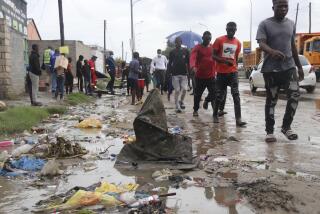Where malaria is a memory
BWEFUM, ZANZIBAR — Like clockwork, particularly on Mondays after his office had been closed for the weekend, the patients would line the concrete benches outside Mininyi Othman’s tiny health center 10 miles from the nearest paved road.
“Every day, so many patients,” said Othman, 63, whose medical training prepared him to be a dental assistant but who has been running the general health clinic here for about 30 years.
Many of the patients were suffering from malaria.
In 2006, the clinic treated 1,158 people for the disease, according to notations recorded by hand on a wall chart. There were 31 cases in 2007. Last month, there were none.
This Monday, Othman had seen 16 patients by midafternoon. Based on symptoms, he tested four for malaria. Each produced negative results.
If Africa, as widely believed, is the center of the global fight against malaria, ground zero is just this sort of hardscrabble village, where roosters strut in the yards and seaweed is dried for sale. Here 9-year-old Hu- dhaima Omar now sleeps under an insecticide-treated net to protect her from the mosquitoes that transmit the disease.
The anti-malaria campaign is exemplified by the clinic and Hudhaima’s home, where light comes in through gaps in the corrugated metal roof and sections are open to the hot, humid air of this island off East Africa. The effort has produced the kind of dramatic turnaround President Bush is heralding on his five-nation, six-day trip across Africa’s midsection.
“For years malaria has been a health crisis in sub-Sahara Africa. The disease keeps sick workers home, schoolyards quiet, communities in mourning,” Bush said Monday as he toured the city of Arusha in mainland Tanzania, where he visited a factory producing bed nets and a hospital treating malaria patients.
Bush announced that the United States, along with Tanzania, the World Bank and the Global Fund to Fight AIDS, Tuberculosis and Malaria, would distribute 5.2 million free bed nets to Tanzanians, which he said would be enough to protect every child in the country between the ages of 1 and 5. He also said vouchers for 5 million nets had been distributed to allow the nets to be purchased at deep discounts for infants and pregnant women.
The effort has grown out of a five-year, $1.2-billion program Bush announced in 2005 intended to cut malaria-related deaths by half in 15 African countries.
The Africa program is built around distributing bed nets; spraying insecticide inside homes; providing specialized medical treatment for the people most vulnerable to malaria, including pregnant women; and offering a combined medical therapy for those who have been infected.
People are being taught how to use the nets; young Hudhaima easily untucked a section from beneath her mattress and ducked under it, a big smile on her face. Radio and television advertising is encouraging people to use the nets and to seek out treatment if they suspect infection.
The results have been dramatic: In Zanzibar, Bush noted, the number of infected infants has dropped from 20% to 1%.
In their tiny village, Hudhaima’s mother, Salma Simba, said she put up the bed net in 2005 and her house has been sprayed three times. Before then, her daughter was being treated regularly for malaria; since then, she has been malaria-free.
For the last decade, Dr. Mahdi Ramsan has been running an anti-malaria program on Zanzibar and neighboring Pemba island, which are part of Tanzania.
Ramsan said the climate of the area, along with a history of poor diagnosis and the unavailability of treatment, had contributed to greater infections and morbidity in the first few years of the decade.
Figures compiled by his office indicated that there were nearly 417,000 suspected malaria infections in 2004 among the two islands’ population of just over 1 million people, many of whom live in mud huts. By last year, the number of suspected cases had dropped to 14,500, while the population had increased by about 100,000.
“I think in a very, very short time we are seeing results,” said Ramsan, who was born in Somalia and trained in Italy.
His office has computers to track malaria infections and treatments, a lab where specimens from difficult cases are studied, and a climate-controlled room where 16 soup bowls and seven box-like net cages are used to breed larvae and adult mosquitoes for testing. The 70% to 80% humidity and 103-degree temperature mimic the ideal climate for the insects.
But a resurgence in malaria cases could be triggered by such factors as a failure to make the bed nets available or to use them properly, a drop in what is called the “indoor residual spraying” program, or even a scaling back of efforts to trim shrubs and drain standing water that give the insects resting places and breeding grounds. It has happened before: As few as 5% of Zanzibaris were infected in the 1960s after another campaign, but the disease resurfaced in recent years.
In the health clinic here, where the fight is being waged near fields where farmers grow bananas, cassava and yams, Othman was asked whether the malaria might return in big numbers. He drew a question mark in the air with his right index finger.
But for the moment, the signs of success are palpable. Indeed, he joked Monday that it was so quiet he might just close up early. There was no one waiting for treatment.
More to Read
Sign up for Essential California
The most important California stories and recommendations in your inbox every morning.
You may occasionally receive promotional content from the Los Angeles Times.










